Q1. Gibberellins promote
Solution
Gibberellin increases the length of hypocotyls and cotyledonary
leaf area during germination. GA induces synthesis of α-amylase and other
hydrolytic enzymes in seeds of monocots and dicots.
Q2. Define development.
Solution
Development can be defined as all the changes which an
organism goes through during its life cycle.
Q3. Mowing the grass lawn
facilitates better maintenance because
Solution
According to Thimann and Skoog, the removal of the
apical bud causes the sprouting of lateral buds with stimulation of the intercalary
meristem and this is the reason that mowing a grass lawn facilitates better
maintenance.
Q4. Plasticity in plant growth means that
Solution
Plant organs change their structures to cope with the change in the environment; this is called the property of plasticity.
Q5. A mass of undifferentiated cells is called
Solution
The dividing cells form a mass of undifferentiated cells called callus.
Q6. Leaves of many grasses are
capable of folding and unfolding because they
Solution
Leaves of monocots are characterised as
isobilateral with dumb bell-shaped guard cells. The upper epidermis possesses
groups of large-sized, thin-walled, vacuolated cells called bulliform or
motor cells. Bulliform cells help in the rolling of leaves during water
stress or drought.
Q7. What is dedifferentiation? State one example.
Solution
As the cells grow and mature, they lose their
capacity to differentiate. However, under certain conditions, such cells
regain the capacity of division which is called dedifferentiation.
Differentiated parenchymatous cells dedifferentiate
to form interfascicular cambium and cork cambium.
Q8. Gibberellin was discovered from
Solution
GA was first isolated by Kurasawa in 1926 from
the fungus Gibberella fujikuroi,
the causal organism of foolish seedling disease of rice plants in Japan.
Q9. Maturation of
dedifferentiated tissues is called
Solution
Redifferentiation is the maturation or
differentiation of dedifferentiated tissues.
Q10. Phytohormones are
Solution
Phytohormones are plant hormones, i.e. organic
substances which are naturally produced in plants and control the growth or
other physiological functions at a site away from their place of synthesis
and are active in extremely minute quantities.
Q11. A plant hormone used for inducing morphogenesis in plant tissue culture
is
Solution
The ratio of cytokinin to auxin controls cell
differentiation. If there is more cytokinin than auxin, then shoot buds
develop. Relatively more auxin than cytokinin leads to the development of
roots. Abscisic acid is known as a natural plant growth inhibitor.
Gibberellin stimulates stem elongation, leaf expansion, bolting, flowering
etc. Ethylene is a fruit-ripening hormone.
Q12. All are extrinsic factors responsible for the development
of an organism except
Solution
Factors responsible for development are
intrinsic and extrinsic. The intrinsic factors include genetic factors and
hormonal factors, and the extrinsic factors include light, temperature etc.
Q13. Name the
fungus which causes the bakanae disease in rice
seedlings.
Solution
Gibberella fujikuroi
Q14. Differentiation of the shoot is controlled by
Solution
The ratio of cytokinins to auxins controls differentiation. If both of these are present in equal quantities, the cells divide but fail to differentiate. If there is more cytokinin than auxin, shoot buds develop. If there is more auxin than cytokinin, roots develop.
Q15. 'Foolish seedling' disease of rice led to the discovery of
Solution
Gibberellins (GA) were first isolated from the fungus Gibberella fujikuroi, the causal organism of foolish seedling disease of rice plants, by Kurasawa in Japan in 1926.
Q16. The phytohormone which induces triple response is
Solution
Ethylene is a gaseous
hormone which stimulates shoot growth, root growth and differentiation which
is otherwise called triple response.
Q17. What is
open form growth?
Solution
Open form
growth is the growth in which new cells are always added to the plant body by
the activity of meristems.
Q18. What are
plant growth regulators? Name the six compounds which fall under the category
of plant growth regulators.
Solution
Plant
growth regulators are small diverse molecules which act as either phytohormones or plant growth substances.
Q19. Growth can be measured in various ways. Which of
these can be used as parameters to measure growth?
Solution
Growth can be measured
when there is an increase in cell number, cell size, length and fresh or dry
weight.
Q20. Which of the following is an
intrinsic factor which controls the development of an organism?
Solution
The process of development is controlled by
intrinsic factors such as genetic and hormonal factors. Extrinsic factors include
light, temperature, water and oxygen.
Q21. If a plant contains more
nitrogenous compounds, then it produces
Solution
If a plant contains more nitrogenous compounds, then
it produces more cytoplasm, less mechanical tissues and vigorous vegetative
growth.
Q22. Which of the following movements in plants is
related to the changes in the auxin level?
Solution
The movement in plants is related to the movement
of shoots towards a source of light due to changes in the auxin level.
Q23. Give one example of cells of plants which have
undergone
Dedifferentiation
Redifferentiation
Solution
Dedifferentiation
- Cells forming cork cambium and interfascicular cambium
Redifferentiation
- Secondary cortex cells and phellem cells
Q24. Name the PGR which is a modified form of adenine.
Solution
Kinetin
Q25. The xylem which differentiates has a thick
secondary wall made of
Solution
The development of a thick secondary wall is made
of lignin, and it becomes living permanent cells of the parenchyma.
Q26. From
where was auxin first isolated?
Solution
Human
urine
Q27. Which amino acid is responsible for indole acetic acid formation?
Solution
IAA is synthesised in shoot apices, leaf primordia and developing seeds from the amino acid tryptophan.
Q28. State the
parameters which are considered while measuring the growth of plants.
Solution
Parameters
which are considered while measuring the growth of plants are as follows:
Increase
in fresh weight
Increase
in dry weight
Increase
in length of plants
Increase
in area and volume of plants
Increase
in cell number
Q29. How is the quantitative comparison between the growth of living beings done?
Solution
The quantitative comparison between the growth of living beings can be done in two ways:
Absolute growth rate: Measurement and comparison of the total growth per unit time.
Relative growth rate: Growth of the given system per unit time expressed on a common basis.
Q30. The time interval between the formative phase and the maturation phase of plant growth is known as
Solution
The formative phase is also called the phase of cell division. New cells are produced by mitotic divisions having meristematic tissue.
Phase of maturation or differentiation is the development of special types of cells by undergoing structural and physiological differentiation.
The intermediate phase between the formative phase and the maturation phase is the phase of elongation.
Q31. From where was auxin isolated first? Name one natural auxin and one synthetic auxin.
Solution
Auxin was first isolated from human urine.
Natural auxin - Indole butyric acid
Synthetic auxin - Naphthalene acetic acid
Q32. Seeds of some plants are unable to germinate even
when conditions are favourable. This is called
Solution
Seed dormancy is the innate inhibition of
germination of a viable seed placed in the most favourable environment for
germination.
Q33. Abscisic
acid is also known as stress hormone.
Solution
Abscisic
acid inhibits seed germination. It also stimulates the closure of stomata and
increases the tolerance level in plants against various stresses. Hence, abscisic acid is also known as a stress hormone.
Q34. Differentiate
between arithmetic and exponential growth.
Solution
Arithmetic
Growth
Geometric
Growth
After mitotic division, only one
daughter cell divides and the other daughter cell differentiates and matures.
All the daughter cells continue
to divide.
On plotting the growth against
time, a linear curve is obtained.
On plotting the growth against
time, a sigmoid curve is obtained.
Q35. What will be the effect on
phytochrome in a plant subjected to continuous red light?
Solution
Continuous exposure to red light causes conversion
of Pr to Pfr which is rapidly destroyed and the inhibition of synthesis of
Pr. Thus, the total amount of phytochrome is decreased.
Q36. Cell elongation in the internodal regions of green plants occurs due to
Solution
Cells elongate due to the presence of the synthetic auxin indole acetic acid. Cell elongation occurs because the cell walls become plastic and due to endosmosis.
Q37. Culturing of plant tissues is
an example of
Solution
Culturing of plant tissues is an example of
dedifferentiation and redifferentiation.
During this technique, a lump of permanent tissue from the portion of pith is
dissected out and cultured on solid culture media.
Q38. What are the important aspects of growth?
Solution
Cell division and differentiation are
important aspects of growth, because cell division is an important phase
which determines the birth of a cell and differentiation is required to
become a permanent cell as morphological change occurs in a meristematic
daughter cell.
Q39. What is the best example of commitment?
Solution
The final structure at maturity of cells appearing due to the same meristem is determined by location of cells. The root cap cells when pushed to the periphery produce the epidermis.
Q40. Coconut milk (coconut water) is widely used in tissue culture because it contains
Solution
Skoog observed that coconut milk contained a substance which stimulated cell division. The substance was later on called cytokinin.
Q41. Ripening of fruit is controlled by
Solution
The ripening of fruits is controlled by
ethylene. Ethylene is produced in plants from the amino acid methionine.
Q42. Which one of the following pairs is not correctly matched?
Solution
Gibberellic acid is a plant hormone, and it helps in cell growth of the stem, leaves and other aerial parts.
Q43. A hormone delaying senescence is
Solution
Richmond and Lang proved that cytokinin
delayed senescence. They observed that application of cytokinins increased
the chlorophyll content which delays senescence for several days.
Q44. The ideal temperature for growth
in plants is
Solution
Growth in many plants is best when the day
temperature is 25°C and the night temperature is 12°C.
Q45. The hormone responsible for apical dominance is
Solution
Apical dominance is the phenomenon in which
the presence of an apical bud does not allow the nearby lateral buds to grow.
This is characteristically caused by auxins.
Q46. What type
of tissues synthesise ethylene? State any two functions of ethylene.
Solution
Ethylene
is synthesised in tissues which undergo senescence and in ripening fruits.
It
accelerates abscission in flowers and fruits.
It breaks
seed and bud dormancy.
Q47. Name the
three substances which were discovered and later collectively named abscisic acid (ABA).
Solution
Inhibitor
B, abscission II and dormin.
Q48. The phenomenon exhibited by
green plants when grown in darkness is called
Solution
If a plant is allowed to grow in complete darkness, then
it shows etiolation.
Q49. The maximum growth rate occurs in
Solution
The maximum growth rate occurs in the exponential
phase because each cell divides to
form two cells. This phase has the greatest
rate of increase in population size. The rate is influenced by
environmental conditions such as temperature, aeration and composition of
medium.
Q50. Intercalary meristem results in
Solution
Cells of the meristematic
region have the capacity to divide. Root apical meristem and shoot apical
meristem contribute to cell elongation of plants which is called primary
growth.
Q51. State the term which explains the ability of plants to respond to the environment or phases of life by following different pathways.
Solution
Plasticity
Q52. When the rate of growth is proportional to the size of the tuber, it is called
Solution
The law of mass growth is the rate of growth which is proportional to the size of the tuber.
Q53. Define
growth. Give an example of growth in plants.
Solution
Growth is
an irreversible permanent increase in the size of an organ or part or the
individual cell. Expansion of leaves is an example of growth in plants.
Q54. Which one of the following plant is LDP?
Solution
LDPs (i.e. long-day plants) require long days of summer which provide the plants perfect photoperiods to permit flowering.
Q55. Name the
phenomenon which explains the importance of low temperature and flowering in
plants.
Solution
Vernalisation
Q56. Which one increases in the
absence of light?
Solution
The absence of light reduces overall growth,
photosynthesis, uptake of minerals and ascent of sap. However, the elongation
of internodes is seen to occur in the absence of light.
Q57. Phytochrome is involved in
Solution
Phytochrome is involved in photomorphogenetic
responses, seed germination, bud dormancy, synthesis of gibberellins and
photoperiodism.
Q58. Twining of tendrils is due to
Solution
Thigmotropism is the curvature movement of a plant
in response to a unilateral stimulus of touch and can be observed in many
climbers. In tendril climbers, the tendrils first show mutation and as soon
as their apices touch a support, they move thigmotropically to turn around
it.
Q59. The increase in total growth
of two organisms and their comparison is known as
Solution
The increase in total growth of two organs or
organisms is measured and the comparison of total growth per unit time is
called absolute growth rate.
Q60. What is the last stage of a plant called?
Solution
The last phase of development is senescence.
Senescence or old age leads to death.
Q61. Geocarpic fruits are produced by
Solution
Geocarpy refers to the ripening of fruits underground. For groundnut, the young fruits are pushed into the soil as a result of the post-fertilisation curvature of the stalk.
Q62. Vernalisation is done at
Solution
Vernalisation is the promotion of flowering in plants at a low temperature. Plants grow vegetatively during the warm season, receive low temperature treatment during the winter and grow further to bear flowers and fruits in the warm season.
Q63. State the
three phases of the period of growth in plants, and describe the
characteristic features of the cells of each phase.
Solution
The
period of growth in plants has the following three phases:
Meristematic
phase:
This phase is represented by the root and shoot apices.
The cells of the meristematic region are rich
in protoplasm and possess large conspicuous nuclei.
The cell walls are thin, cellulosic, primary
and show more plasmodesmata connections.
Elongation
phase:
The zone of elongation is proximal to the meristematic zone.
The cells show more number of vacuoles.
Enlargement of cells and new cell wall
deposition occur during this phase.
Maturation:
It lies proximal to the zone of elongation.
The cells of this phase show more
protoplasmic modifications and thickened cell walls.
Q64. Describe arithmetic growth.
Solution
In arithmetic growth following mitotic cell division, only one daughter cell continues to divide while the other daughter cell differentiates and matures.
When arithmetic growth is plotted against time, it gives a linear growth curve.
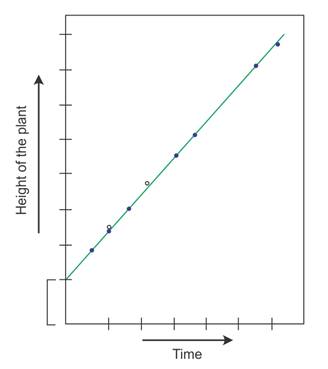 The mathematical expression of arithmetic growth is
Lt = L0 + rt,
where Lt = length at time ‘t’
L0 = length at time zero
r = growth rate
The mathematical expression of arithmetic growth is
Lt = L0 + rt,
where Lt = length at time ‘t’
L0 = length at time zero
r = growth rate
 The mathematical expression of arithmetic growth is
Lt = L0 + rt,
where Lt = length at time ‘t’
L0 = length at time zero
r = growth rate
The mathematical expression of arithmetic growth is
Lt = L0 + rt,
where Lt = length at time ‘t’
L0 = length at time zero
r = growth rate
Q65. Cholodny-Went theory is concerned with which of the following processes:
Solution
The Cholodny-Went model which was proposed in 1927 showed a tendency for the shoot to grow towards light and for the roots to grow downwards.
Q66. Which method out of the following renders the seed coat permeable to water so that embryo expansion is not physically retarded?
Solution
In many plants, the seed coat is quite tough and provides mechanical resistance to the growth of the embryos. Scarification by abrasion through machine, threshing, filling etc., ruptures or weakens the seed coat and promotes germination.
Q67. How many
cells can a single maize root apical meristem produce in one hour?
Solution
17,500
Q68. Draw a chart indicating the sequence of development in plants.
Solution
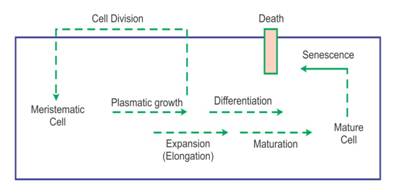
Q69. The increase of growth per
unit time is defined as
Solution
Growth of an organism is expressed in the form of
growth rate which is defined as the increase of growth per unit time.
Q70. Name the
plant growth regulator used in the brewing industry for the malting process.
Solution
Gibberellic acid
Q71. Crescograph and auxanometer are
Solution
Growth is measured by measuring an increase in length, volume, area,
diameter etc.
A crescograph is a device to measure the growth in plants which showed
how the rate of growth varies under varying stimuli.
So, an auxanometer is used to measure the growth in length of a plant
organ.
Q72. Name any
two parts of the plant which synthesise natural cytokinins.
Solution
Young
fruits, root apices
Q73. Name the
meristems which cause secondary growth in plants.
Solution
Lateral
meristems, vascular cambium and cork cambium.
Q74. Write the
mathematical expression for exponential growth.
Solution
W1
= W0ert
Q75. State any two extrinsic factors important in the
development of a plant.
Solution
Light and oxygen
Q76. How do gibberellins help in increasing the sugar yield?
Solution
Gibberellins help in stem elongation in plants. In sugarcane, sugar is stored in stems. Use of gibberellin ensures an increase in the stem length of sugarcane; hence, the yield increases.
Q77. Which is a stress hormone?
Solution
Abscisic acid is called a stress hormone because the production of this hormone is stimulated by drought, water logging and other adverse environmental conditions.
Q78. An auxanometer is used to
measure
Solution
Growth is measured by measuring an increase
in length, volume, area, diameter etc. So, an auxanometer is used to measure
the growth in length of a plant organ.
Q79. Represent diagrammatically the locations of root and shoot apical meristems and the direction of the growth of cells in meristems.
Solution
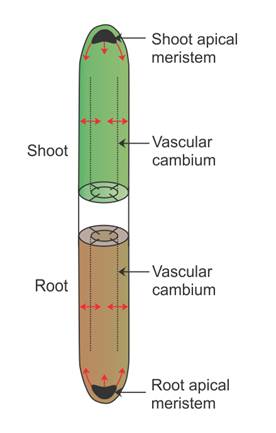
Q80. Name the component which a plant cell loses in order
to form a tracheary element.
Solution
Protoplasm
Q81. Phytochrome is involved in
Solution
Phytochrome is a photosensitive pigment which exists in two states. It is involved in photomorphogenetic responses, seed germination, bud dormancy, synthesis of gibberellin and ethylene and photoperiodism.
Q82. A short-day plant is
Solution
In short-day plants, the length of night is
critical. Xanthium strumarium is a short-day
plant which flowers after 9 hours of dark period irrespective of the day
length. Even if a brief flash of light is interrupted by a dark period, the
flowering is inhibited.
Q83. How does ethylene help plants to absorb more water and minerals?
Solution
Ethylene promotes root growth and root hair formation, thus increasing the surface area of absorption which helps plants to absorb more water and minerals.
Q84. Define plasticity and give one example.
Or
How can heterophylly be an example of plasticity?
Solution
Plasticity is the ability of plants to respond to
the environment or phases of life or to form different structures by
following different pathways.
Terrestrial plants have different shapes of leaves,
and the leaves of aquatic plants also show different shapes in their life
cycle.
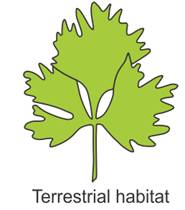
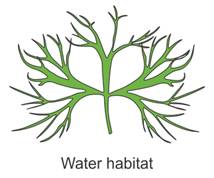 A coriander leaf in the juvenile stage looks
different from the mature leaf.
A coriander leaf in the juvenile stage looks
different from the mature leaf.
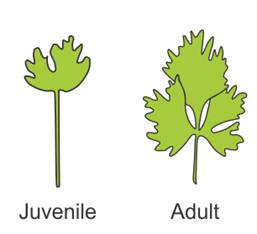

 A coriander leaf in the juvenile stage looks
different from the mature leaf.
A coriander leaf in the juvenile stage looks
different from the mature leaf.

Q85. Name the
plant and its part from which auxin was isolated by
F. W. Went.
Solution
Tips of
coleoptiles of oat seedlings.
Q86. State the term used for the phenomenon in which the shape of leaves of the same plant changes during its development.
Solution
Heterophylly
Q87. Name the auxin which is used as a weedicide.
Solution
2,4-dichlorophenoxyacetic
acid
Q88. Name the
phenomenon in which a growing apical bud inhibits the growth of the lateral
bud.
Solution
Apical
dominance
Q89. Name the
compound which is used in agriculture as a source of ethylene.
Solution
Ethephon
Q90. Define
growth rate.
Solution
The growth
rate is the increased growth per unit time.
Q91. Describe
relative growth. Also, plot a graph indicating relative growth.
Solution
In geometric growth, the progeny cells
continue to divide mitotically.
The initial phase, i.e. the lag phase, is
very slow.
After the lag phase, the growth takes place
very rapidly at an exponential rate, which is called the log phase.
Due to limited nutrient supply, the growth
slows down leading to the stationary phase.
When a graph is plotted of the growth rate
against time, we get a sigmoid or S curve.
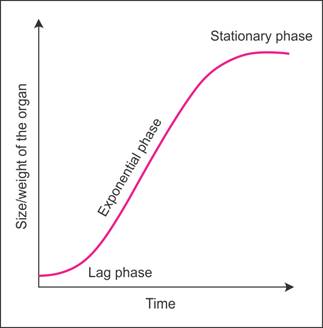 The geometric growth rate is expressed as
W1 = W0ert,
where W1 = final size (weight,
height, number etc.)
W0
= initial size at the beginning of the period
r =
growth rate
t = time of growth
e =
base of natural logarithm
The geometric growth rate is expressed as
W1 = W0ert,
where W1 = final size (weight,
height, number etc.)
W0
= initial size at the beginning of the period
r =
growth rate
t = time of growth
e =
base of natural logarithm
 The geometric growth rate is expressed as
W1 = W0ert,
where W1 = final size (weight,
height, number etc.)
W0
= initial size at the beginning of the period
r =
growth rate
t = time of growth
e =
base of natural logarithm
The geometric growth rate is expressed as
W1 = W0ert,
where W1 = final size (weight,
height, number etc.)
W0
= initial size at the beginning of the period
r =
growth rate
t = time of growth
e =
base of natural logarithm
Q92. Light grown seedlings are
Solution
Light grown seedlings are sturdy, green with
shorter internodes, expanded leaves and upright apex.
Q93. Who
identified kinetin first?
Solution
Skoog
and Miller
Q94. State the characteristics of cells in the elongation phase of the growth of a plant.
Solution
Cells in the elongation phase of the growth of a plant show the following characteristics:
They show increased vacuolation, i.e. more number of vacuoles.
Cells are enlarged.
There is new cell wall deposition.
Q95. State the intrinsic factors important in the
development of plants.
Solution
Genetic factors and growth regulators
Q96. From
where was kinetin isolated for the first time? Where are the natural cytokinins synthesised in plants?
Solution
Kinetin
was first isolated from herring sperm. Natural cytokinins
are synthesised in areas of rapid cell division.
Q97. State the
name of the plant growth regulator which you will use in the following cases:
To
promote flowering in pineapples
To
stimulate early seed production in conifers
To
sprout potato tubers
To
prevent leaf drop at an early age
To
prepare weed-free lawns
To
delay leaf senescence
Solution
To
promote flowering in pineapples - Auxins
To
stimulate early seed production in conifers - Gibberellins
To
sprout potato tubers - Ethylene
To
prevent leaf drop at an early age - Auxins
To
prepare weed-free lawns - Auxins
To
delay leaf senescence - Cytokinins
Q98. What does a sigmoid growth curve indicate?
Solution
A sigmoid growth curve indicates that the living organism is growing in a natural environment.
Q99. Name the
PGR which hastens the ripening of oranges.
Solution
Ethylene
Q100. State the
functions of cytokinins.
Solution
Functions
of cytokinins:
They help to overcome apical dominance.
They also promote nutrient mobilisation
which results in the delay of leaf senescence.
Comments
Post a Comment